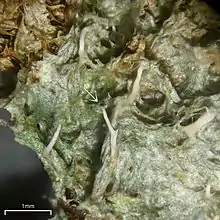Gomphillaceae
The Gomphillaceae are a family of lichen-forming fungi in the order Graphidales. Species in this family are found mostly in tropical regions.[1]
| Gomphillaceae | |
|---|---|
 | |
| Gomphillus americanus | |
| Scientific classification | |
| Domain: | Eukaryota |
| Kingdom: | Fungi |
| Division: | Ascomycota |
| Class: | Lecanoromycetes |
| Order: | Graphidales |
| Family: | Gomphillaceae Walt.Watson (1929) |
| Type genus | |
| Gomphillus Nyl. (1855) | |
| Synonyms | |
| |
Description
The family Gomphillaceae is characterized by its crust-like thallus, which is the outer layer of the lichen body. These lichens contain chlorococcoid photobionts, which are symbiotic algae that help the lichen to produce food through photosynthesis. The reproductive structures of Gomphillaceae lichens, known as ascomata, can be apothecioid or lirellate in form. Apothecia occur in a few forms, including biatorine or zeorine to sometimes lecideine.[2]
The internal structure of hymenium (the fertile, spore-producing part of the lichen), called the hamathecium, consists primarily of branched and interwoven paraphyses. The asci, or spore-producing sacs, are annelasceous and feature a distinctive apical tholus and ring structure. They can be clavate, oblong, or fusiform in shape and do not exhibit any amyloid properties. These asci typically produce eight ascospores, although some may produce fewer, ranging from one to four spores. The ascospores are hyaline (transparent), and have thin walls and distinct eusepta. They can be ellipsoid or oblong in shape, and their internal divisions (septa) can be transverse or muriform.[2]
Gomphillaceae lichens also produce conidiomata, which are asexual reproductive structures. These are mostly hyphophores, and the conidia are formed as branched hyphae, called diahyphae, within gelatinous masses. The conidia are typically septate, often taking on a moniliform or bead-like appearance, and are also hyaline. In terms of secondary chemistry, Gomphillaceae lichens generally lack any notable substances.[2]
Genera
According to a recent (2022) estimate, the Gomphillaceae comprise 26 genera and about 425 species. The following list indicates the genus name, the taxonomic authority, year of publication, and the number of species:[3]
- Actinoplaca Müll.Arg. (1891) – 2 spp.
- Aderkomyces Bat. (1961) – 30 spp.
- Aplanocalenia Lücking, Sérus. & Vězda (2005) – 1 sp.
- Arthotheliopsis Vain. (1896) – 5 spp.
- Asterothyrium Müll.Arg. (1890) – 32 spp.
- Aulaxina Fée (1825) – 14 spp.
- Calenia Müll.Arg. (1890) – 30 spp.
- Caleniopsis Vězda & Poelt (1987) – 2 spp.
- Corticifraga D.Hawksw. & R.Sant. (1990) – 9 spp.
- Diploschistella Vain. (1926) – 4 spp.
- Echinoplaca Fée (1825) – 40 spp.
- Ferraroa Lücking, Sérus. & Vězda (2005) – 1 sp.
- Gomphillus Nyl. (1855) – 6 spp.
- Gyalectidium Müll.Arg. (1881) – 52 spp.
- Gyalidea Lettau ex Vězda (1996) – 50 spp.
- Gyalideopsis Vězda (1972) – 91 spp.
- Hippocrepidea Sérus. (1997) – 1 sp.
- Jamesiella Lücking, Sérus. & Vězda (2005) – 4 spp.
- Lithogyalideopsis Lücking, Sérus. & Vězda (2005) – 4 spp.
- Paragyalideopsis Etayo (2017) – 4 spp.
- Paratricharia Lücking (1997) – 1 spp.
- Phyllogyalidea Lücking & Aptroot (2008) – 2 spp.
- Psorotheciopsis Rehm (1900) – 7 spp.
- Rolueckia Papong, Thammath. & Boonpr. (2008) – 3 spp.
- Taitaia Suija, Kaasalainen, Kirika & Rikkinen (2018) – 1 spp.
- Tricharia Fée (1825) – ca. 30 spp.
References
- Cannon PF; Kirk PM (2007). Fungal Families of the World. Wallingford, UK: CAB International. pp. 142–143. ISBN 0-85199-827-5.
- Jaklitsch, Walter; Baral, Hans-Otto; Lücking, Robert; Lumbsch, H. Thorsten (2016). Frey, Wolfgang (ed.). Syllabus of Plant Families: Adolf Engler's Syllabus der Pflanzenfamilien. Vol. 1/2 (13 ed.). Berlin Stuttgart: Gebr. Borntraeger Verlagsbuchhandlung, Borntraeger Science Publishers. pp. 140–141. ISBN 978-3-443-01089-8. OCLC 429208213.
- Wijayawardene, N.N.; Hyde, K.D.; Dai, D.Q.; Sánchez-García, M.; Goto, B.T.; Saxena, R.K.; et al. (2022). "Outline of Fungi and fungus-like taxa – 2021". Mycosphere. 13 (1): 53–453 [160]. doi:10.5943/mycosphere/13/1/2. S2CID 249054641.